Course creators use automated webinars to capture leads and find new students for their online courses. They put carefully crafted webinars at the center of an evergreen funnel and automate as much of their sales process as possible, putting it on autopilot and redirect their time and energy toward other things.
Choosing the right automated webinar platform can be tricky. With so many options available, it can be hard to determine which one is best for your needs.
In this article, we’ll explore the seven best automated webinar platforms for course creators, making the process of choosing one as painless as possible.
Jump ahead:
- Why you should use automated webinar software
- Choosing the best automated webinar software
- Top 8 automated webinar software systems
- Time to make your choice
Why you should use automated webinar software
Automated webinar software is used to create and host pre-recorded webinars that run on autopilot. It’s an effective way to generate leads and move them through the sales process without needing to be live every day.
Read more: How to Use Evergreen Automated Webinars in your Funnel
These platforms are great for course creators because they allow you to create videos, slideshows, and other content and deliver it to your audience at any time, even when you’re not available. They also provide powerful analytics so you can measure the performance of each webinar and make tweaks as needed.
Webinars are great for lead generation and sales conversion, but they’re also an effective way to build relationships with your audience. They allow you to connect with potential customers in a more intimate setting and increase trust by answering their questions and demonstrating expertise. Automating webinars makes it even easier to build these relationships.
You can set up an evergreen webinar, bake it into your sales funnel, and make it available as often as you like without ever having to be there to host it. This requires upfront effort to get things set up, but after that, an automated webinar doesn’t require much attention outside of answering questions from attendees. What felt unmanageable before becomes easy.
Course creators like Kyshira Moffet of HERMovement and Carly Adams of Tidy Revival use automated webinars to grow their businesses 24/7. Kyshira automated one of her sales webinars and made nearly $15,000 within the first week. Carly loves automated webinars because they save her a ton of time. “I’m not having to take time out of my week again and again and again, to do the same presentation. People are able to get that information when it’s most convenient for them.” Read Kyshira and Carly’s stories if you want to learn more about what they did and how they did it.
Haley Burkhead, Founder and CEO of Recurring Profit, specializes in helping course creators scale the sales of their course or membership site using automated webinars, just like she did with her own business. She shares:
“I SCALED MY BUSINESS TO $400K+ A MONTH OF RECURRING REVENUE BY CHOOSING TO AUTOMATE MY WEBINAR. BY AUTOMATING MY SALES MACHINE, I CAN SPEND MORE TIME ON SERVING MY CLIENTS AND CREATING A VISION INSTEAD OF ALWAYS NEEDING TO BE IN SALES MODE.”
In this free 30-minute webinar, Haley explains her method and walks through the free webinar template she designed so that you can create an automated webinar of your own. (Since Haley’s webinar is automated, by joining it you’ll get to have the experience of attending an automated webinar too!)
Read more: Use this Free Webinar Outline Template for More Impact
Choosing the best automated webinar software
The biggest advantage of an automated webinar is that it’s available at any time, so prospects can join a session when it’s convenient for them without waiting. You or anyone on your team should never have to be there to host or attend it in order for it to be a success.
In spite of you not being there, your webinar still needs to be engaging enough for people to want to stay for the whole presentation and convert to a paying customer. For this to happen, the experience must be interactive and give attendees a way to get their questions answered. If you can find automated webinar software that makes all of these things possible, you are 90% of the way there.
To help you in the process of choosing an automated webinar platform, we’ve grouped the features you should look at most closely into four categories:
FULL DISCLOSURE: This is a guest post from eWebinar, the only automated webinar software provider 100% dedicated to automation, and the only one available in the Thinkific app store. We are, of course, biased towards our own product, but that’s only because we struggled for years with the shortcomings of existing software and are now dedicated to solving them. That being said, we have sought to be as objective as possible when evaluating other products, so you can make an informed decision as you go about picking one.
With live webinars, you’re only ever able to schedule them when you are available to host them. It is all about what fits into your calendar. With automated webinars, it’s the opposite. You want your webinars to be available whenever your prospects want to watch them, which could literally be at any time. And that’s the point! Choose software that will give your registrants maximum flexibility when choosing when to join your webinars.
Here are five key questions to ask yourself about scheduling features:
- Does the software support a recurring schedule, including the ability to add a start date, end date (with the option to have the webinar run indefinitely), and recurring session times on whatever days of the week you choose (i.e. 10am, 2pm, and 4pm, Monday through Friday)?
- Can you make sessions available in the local time zones of attendees, so sessions are always at convenient times of day regardless of where attendees live in the world?
- Does it have good just-in-time or on-demand options, so attendees can join a webinar within moments of discovering it, at a moment of high intent? (This is critical!)
- Can people register to watch a replay in lieu of attending a regular session, so they can watch it at their convenience, pause, skip ahead, or watch at 2X speed?
- Can you enable all of the options above for the same webinar, so attendees can decide when (and how) they want to watch your webinar so they actually show up for it?!
NOTE: The last question is the most important one of all. Several solutions offer all of the features mentioned above, but only a few make it possible to enable them all for the same webinar. For example, some solutions have on-demand webinars, but they can only be on-demand; you can’t also offer sessions on a recurring schedule for the same webinar.
When people attend a webinar, they may want or expect to be able to chat live with someone. At the very least, they want to know they’ll be able to get their questions answered in a timely way. This obviously becomes a challenge with automated webinars, since you won’t always be around to respond to messages live and you certainly don’t want to have to join every single session to chat with attendees since that would defeat the purpose of round-the-clock scheduling.
On the other hand, from a sales perspective, it is a golden opportunity you don’t want to miss to chat with prospects, answer their questions, and resolve any objections they might have while they are watching your webinar and deciding — in that very moment — whether or not to buy your course.
Read More: Use This Webinar Follow Up Email Template To Convert More Attendees
The goal then should be to find software that gives you the best of both worlds, the ability to jump in and chat live with attendees when you can but the flexibility to respond to messages later by email when you can’t.
With this in mind, here are four questions to ask yourself related to the chat features of any software you are considering:
- Does the software give you the flexibility to chat live with attendees when you can, including notifications of new messages and a mobile-friendly chat admin for when you are on the go?
- Can you respond to questions from attendees by email when you are not free to chat live (or if the software does not support live chat in a way that lets you jump in as needed)?
- Does the software encourage conversations with attendees with features like automated welcome messages, scheduled private messages, and private chat (since people are much more comfortable asking questions privately than they are publicly)? Or does it discourage or even prevent them?
- How does the software manage attendees’ expectations when you are not available to chat (or are unable to chat with them because of the limitations of the software), so they aren’t left feeling discouraged and unheard?
NOTE: Some software supports simulated chat, which gives the impression chat is live when it is not and that an attendee will be able to get a response from you when they won’t. We advise against using this feature. It’s not worth risking losing your credibility.
With an automated webinar, you are not going to be there to present it live. You will not always be available to chat live with attendees either. This means your webinar must be engaging enough to hold people’s attention without you being there.
A well-structured, compelling presentation is obviously key to that. And though chat will often help fulfill this need too, if you want to keep people interested until the end of your webinar (which is generally when you make your offer to purchase), it must have interactive elements — like polls, questions, tips, and more — that give them a way to participate in the experience. Otherwise, they will get bored and leave.
Interactivity serves two purposes. Outside of keeping attendees engaged, it also gives you a way to collect information from them, like the answers to qualifying sales questions, feedback about whether or not your webinar is resonating, or data to segment your audience for effective post-webinar marketing automation.
With these things in mind, here are a few questions to ask yourself about the interactive features of automated webinar software:
- Does the software offer a wide variety of interactions, like polls, questions, tips, links, downloads, contact forms, and more, so you have an arsenal of options at your disposal to keep attendees engaged?
- Is it easy to add interactions throughout your webinar or do they overlap and interfere with each other (or are they overly cumbersome to add during the webinar creation process)?
- Do they support audience reactions (i.e. “likes) that give attendees another way to participate in the experience and that, ideally, accumulate over time?
- Can you integrate the data you collect through interactions with your CRM or email marketing software, so you can effectively market to attendees after the webinar?
TIP: If you want to know whether or not the experience of your automated webinar will be as interactive and engaging as you would like it to be, attend one hosted using the software you are considering. Did the webinar hold your attention even though it was pre-recorded? Did you feel like you could get your questions answered? Was the experience one-way and passive or two-way and interactive? Ask yourself if it’s the experience you would want for your own customers.
If you’ve used webinar software before, you probably already know it can be very difficult to figure out. As you evaluate software, make sure you are comfortable with its learning curve and how hard or easy it will be to use on an ongoing basis.
We think the easiest way to determine how easy a webinar product is to use is to sign up for a free trial and create a webinar from scratch without any instruction.
When you are done, ask yourself the following questions:
- How long did it take you? More than 10 minutes?
- How many times did you have to click to see all of your options? More than 10 times?
- Did you need to reach out for help?
- Did you need to watch a help video?
- Do you think it would be easy to remember where everything was when you went back in to make edits?
- Could you tell what the finished product would look like to attendees as you were editing? Or did you have to guess?
- How did the overall process make you feel? Frustrated and confused? Or did it put you at ease in terms of the learning curve?
This kind of exercise, especially when you are comparing two different products, is incredibly revealing. Don’t rush this part of the software evaluation process as you may be living with whatever choice you make for a long time.
NOTE: While the features we discussed above are the most important to consider when choosing automated webinar software, there are a handful of others you should look at to make sure they meet your needs. They are registration pages, registration widgets (especially if you want to use a third-party registration page), email notifications, integrations (if you use a CRM or email marketing platform), and analytics.
Top 8 automated webinar software systems
We have made a list of the top eight automated webinar software systems you should consider choosing to scale the sales of your online course or program. Each product has been described below in the context of three of the four feature groups described above: scheduling, communication, and interactivity.
Now let’s explore the eight best automated webinar platforms so you can make an informed decision about which one is right for your needs:
A note about pricing: Most course creators have a single automated sales webinar. We have indicated below for each product the month-to-month rate you would pay if you did the same. Some products do not offer automated webinars at their lowest tier. Others offer discounts if you pay annually.

eWebinar is 100% dedicated to automated webinars. Built from the ground up with this singular focus, eWebinar is the only automated webinar software on this list that offers all of the features and fully meets all of the criteria described above.
If you’d like to learn more about eWebinar or just experience it for yourself as an attendee, join our 20-minute on-demand demo or sign up for a free trial. eWebinar has a 5-star rating on Capterra. Read the reviews.
Scheduling: You can enable all key scheduling features at the same time for any of your webinars, giving your audience the most choice possible when deciding when and how to join your webinar. These features are a recurring schedule (that can show session times in the attendee’s local time zone), just-in-time webinars, and on-demand webinar replays.
Communication: eWebinar’s private chat system is its most unique and differentiating feature. The way it works is you get notified when someone sends you a message (by email, browser notification, or in Slack, if you’ve set up the integration). If you’re away from your computer, you can easily respond from the mobile-friendly chat admin (or via the Slack app on your phone). If you or your team aren’t free to chat live, you can reply later and the attendee will get your response by email. No other software gives you this kind of flexibility. Other unique chat features include automated welcome messages, scheduled private messages, an autoresponder, unlimited team members to help you manage chat, and automatically emailed chat transcripts.
Interactivity: eWebinar offers 12 different types of interactions, more than any other software, so your webinars will always be interactive, engaging, and fun. Use them to gather critical data from your audience and to increase your webinar watch time to 90% or more.
Usability: eWebinar’s interface is clear and intuitive. A simple 5-step wizard walks you through the webinar creation process. No features are hidden within sub-tabs or accordions. You can see all of your options in only 8 clicks and preview your work as you go. The average time it takes for someone to set up their first eWebinar is less than 10 minutes, without any instruction.
Pricing and packaging:
- 14-day free trial
- Level 1 – $49/month
- Level 2 – $99/month
- Level 3 – $199/month
- Level 4 – $250/month and up
Other notable features:
- Only product listed that fully meets the criteria and has all the features outlined in this article
- Only product that directly integrates with Thinkific and is available on their app store
- Comes with 3 free webinar templates and many other free resources specifically developed for course creators
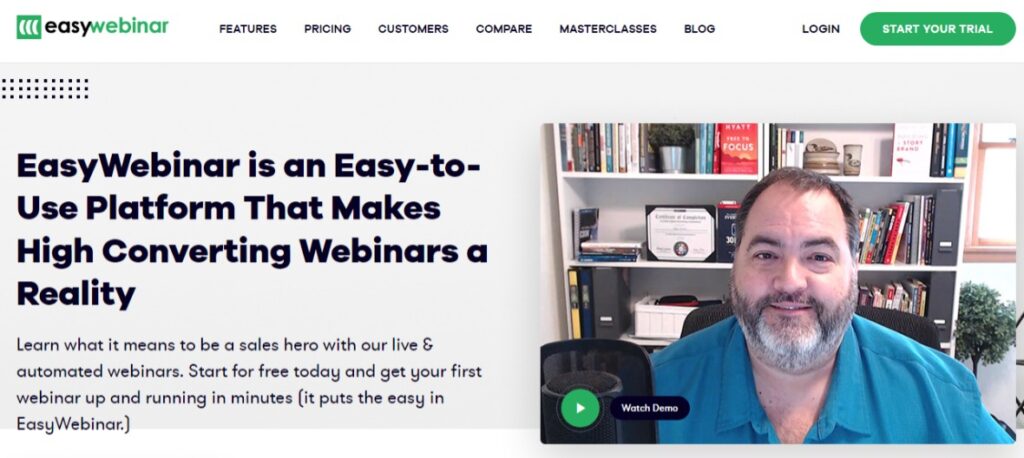
EasyWebinar offers both live and automated webinars and is a good option for course creators, especially those who are brand new to webinar marketing.
EasyWebinar has 4.4 out of 5 stars on Capterra. Read the reviews.
Scheduling: EasyWebinar has a recurring schedule that supports sessions in attendees’ local time zones, replays, and just-in-time registrations.
Communication: They do not offer live chat in their automated webinars, though you can reply to attendee messages by email.
Interactivity: EasyWebinar has two types of interactions: polls and offers.
Pricing and packaging:
- 14-day free trial
- Standard – $78/month
- Professional – $129/month
- Enterprise – $499/month
Other notable features:
- Convert recordings of live webinars into automated webinars within the platform
- Offers four registration page themes that were designed for sales webinars
- Social share incentive to help boost traffic to your registration page

Demio is known primarily as a live webinar platform but evolved to support automated webinars. They are most popular with SaaS companies.
Demio has 4.8 out of 5 stars on Capterra. Read the reviews.
Scheduling and communication: The scheduling and chat features are tied together in Demio and allow for two basic paths:
- A recurring schedule + live chat (though you must join every session to do it)
- On-demand webinars + the ability to respond to questions from attendees by email
Interactivity: Demio has three types of interactions: CTAs (which can be used for your purchase offer), polls, and handouts.
Pricing and packaging:
- 14-day free trial
- Starter – $49/month
- Growth – $99/month
- Premium – contact for pricing
Other notable features:
- Either schedule sessions for your webinar or make it available on demand instead
- Modern design with a straightforward setup process
- Knowledge base with comprehensive documentation and good support
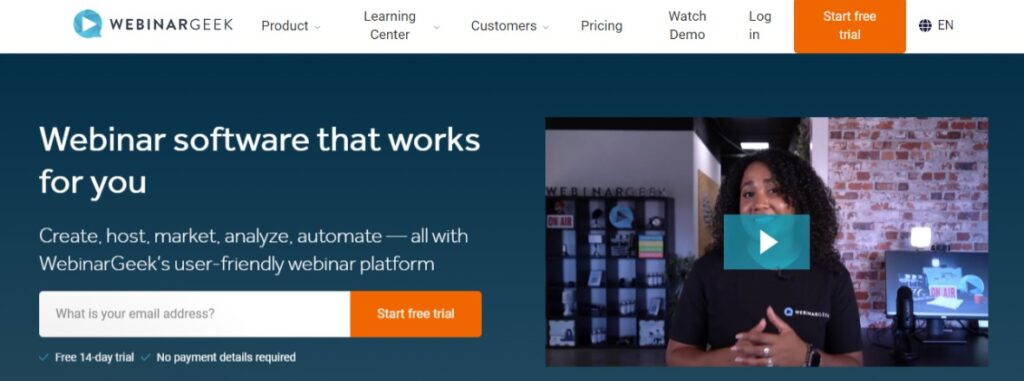
WebinarGeek is an all-in-one webinar solution that offers both live and automated webinars.
WebinarGeek has 4.6 out of 5 stars on Capterra. Read the reviews.
Scheduling: You have two options for how you schedule your webinars in WebinarGeek that are mutually exclusive: recurring schedule in the time zones of attendees OR on-demand sessions only.
Communication: Similar to scheduling, you have two mutually exclusive options for how you set up chat in WebinarGeek: live chat only (with email notifications of new messages) OR attendee questions forwarded to your email.
Interactivity: WebinarGeek has four kinds of interactions: CTAs, polls, info boxes, and quizzes.
Pricing and packaging:
- 14-day free trial
- Starter – $22/month
- Premium – $67/month
- Advanced – Contact for pricing
Other notable features:
- Record a live webinar and then use the video to create an automated webinar
- Consistent editing experience across email notifications and registration pages
- Simulated chat to give attendees the impression they are watching a live webinar
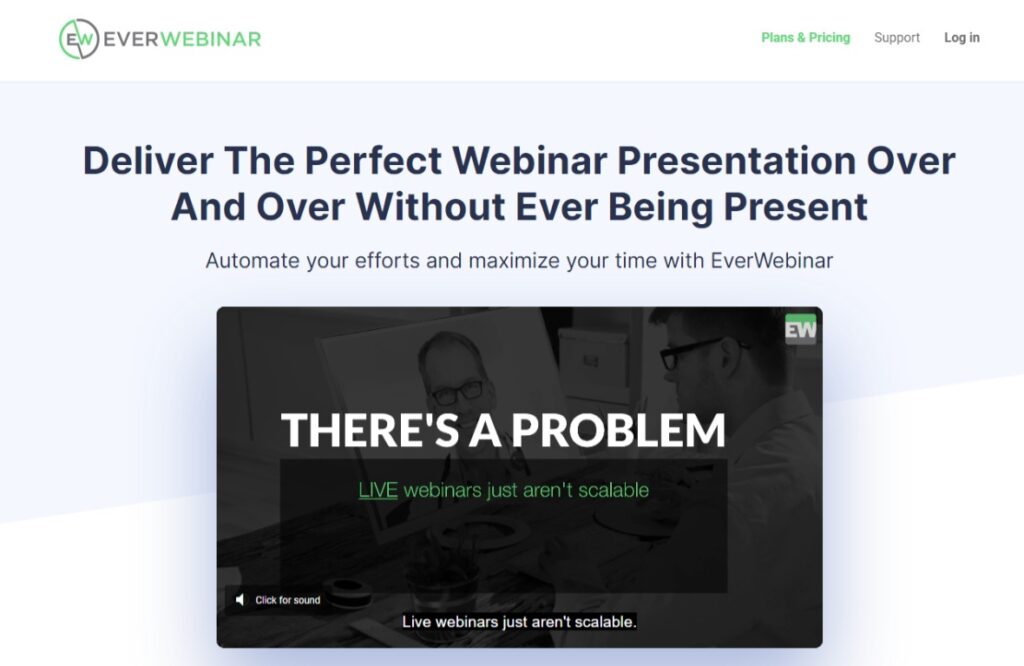
EverWebinar is automated webinar software from Genesis Digital a company that also makes live webinar software, WebinarJam.
EverWebinar has 3.8 out of 5 stars on Capterra. Read the reviews.
Scheduling: EverWebinar supports a recurring schedule with sessions in the attendee’s time zone, just-in-time sessions, and replays.
Communication: EverWebinar does not have live chat. Attendees can send questions to your email in replays only.
Interactivity: EverWebinar has seven types of interactions: stickies, handouts, surveys, offers, polls, announcement banners, and handouts.
Pricing and packaging:
- 30-day money back guarantee
- Monthly Plan – $99/month
- Annual Plan – $42/month
- Biennial Plan – $34/month
Other notable features:
- Import recordings of live webinars from WebinarJam to use as evergreen webinars
- Library of registration page templates and the ability to split test them
- Simulated live chat, simulated attendees, and simulated sales notifications
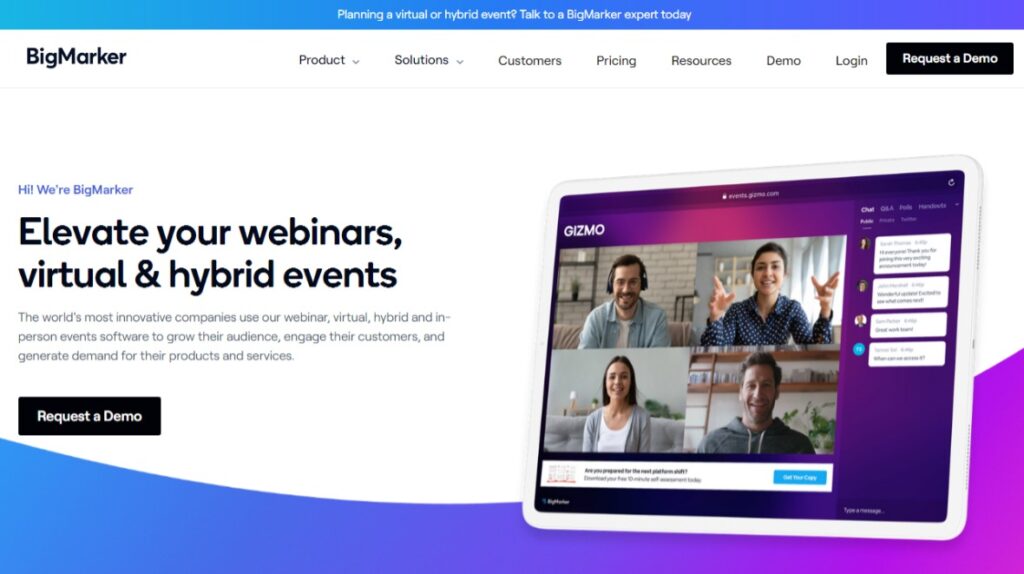
BigMarker is a webinar and virtual event platform that excels in live webinars and events.
BigMarker has 4.8 out of 5 stars on Capterra. Read the reviews.
Scheduling: BigMarker supports a recurring schedule with sessions in attendees’ local time zones, just-in-time sessions, and replays (though replays must be created as a separate webinar).
Communication: BigMarker has public, live chat with SMS or Slack notifications of new messages. They do not offer a way to respond to attendee questions by email after the webinar.
Interactivity: BigMarker offers eight types of interactions: polls, questions, handouts, offers, sticky notes, chat messages, attendance monitor, and post-webinar feedback.
Pricing and packaging:
- 7-day free trial
- Starter – $99/month
- Elite – $189/month
- Premier – $399/month
- White Label – Contact for pricing
Other notable features:
- Slack integration for responding to public chat messages
- Emoji audience reactions
- Attendance monitor and post-webinar surveys
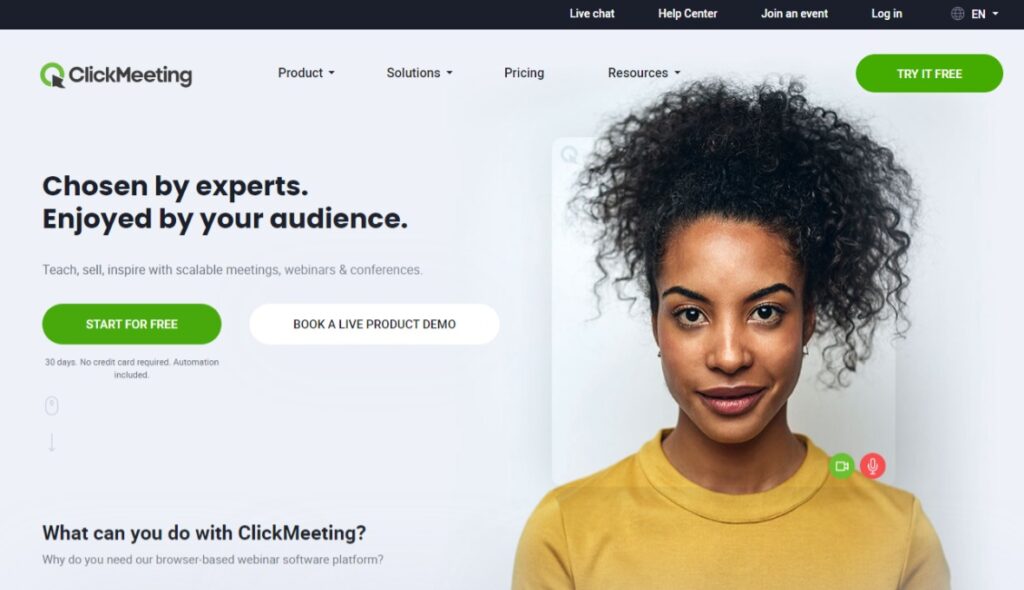
ClickMeeting is a webinar platform with an emphasis on branding.
ClickMeeting has 4.3 out of 5 stars on Capterra. Read the reviews.
Scheduling: ClickMeeting supports a recurring schedule in attendees’ local time zones, just-in-time sessions, and replays.
Communication: ClickMeeting offers public, live chat with email notifications of new messages. They do not offer a way to respond to attendee questions by email after the webinar.
Interactivity: ClickMeeting has six kinds of interactions: polls, surveys, Q&As, info boxes, offers, and file sharing.
Pricing and packaging:
- 30-day free trial
- Basic – $25/month
- Standard – $41/month
- Advanced – $83/month
- Pro – $166/month
- Enterprise – Contact for pricing
Other notable features:
- Customizable registration and thank-you/follow-up pages
- Live poll analytics
- In-webinar surveys
- Simulated attendees to give the impression that the webinar is live
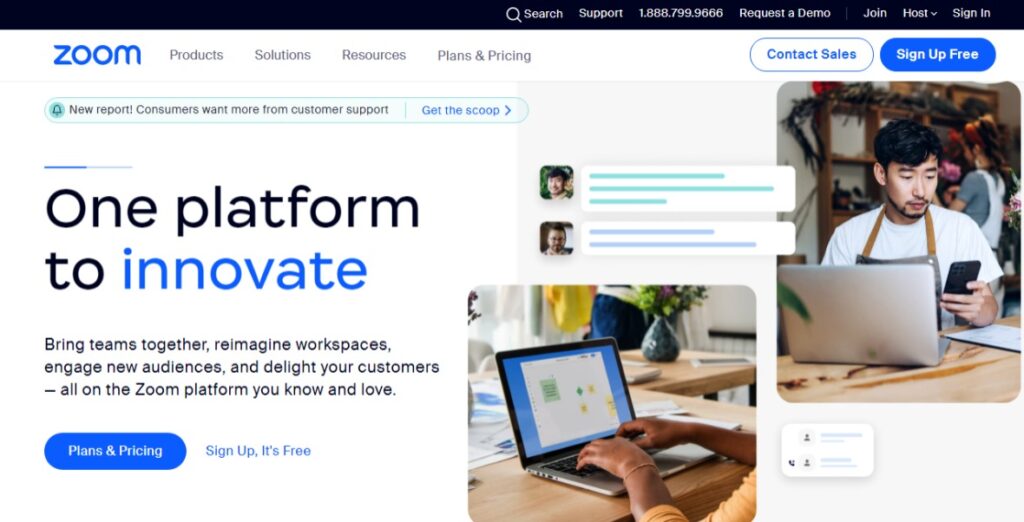
Zoom Webinar is part of the Zoom suite of products, which includes video conferencing software as well.
Zoom Webinar has 4.6 out of 5 stars on Capterra. Read the reviews.
Scheduling: Zoom Webinar supports a recurring schedule in attendees’ local time zones, just-in-time sessions, and replays.
Communication: Zoom Webinar offers public live chat with email notifications of new messages. They also offer a way to respond to attendee questions by email after the webinar.
Interactivity: Zoom Webinar has seven kinds of interactions: polls, surveys, Q&As, info boxes, offers, file sharing, and whiteboards.
Pricing and packaging:
- Free version
- Pro – $14.99/month/host
- Business – $19.99/month/host
- Enterprise – Contact for pricing
Other notable features:
- Registration page templates
- In-webinar surveys
- Simulated attendees to give the impression that the webinar is live
- Zoom Rooms integration for larger in-person events
- HIPAA compliance available with the Enterprise plan.
Time to make your choice
One of the biggest challenges course creators face is figuring out how to scale their revenue and sales once they reach the limit of what they can accomplish on their own by sheer force of will. Automated webinars are a proven method for pushing past those limits to new levels of success and revenue, not to mention the time-saving benefits.
We hope this guide has given you an idea of the features and capabilities available in the most popular automated webinar software solutions on the market today. No matter what automated webinar software you choose, an automated webinar sales funnel can have a major impact on the success of your business.







